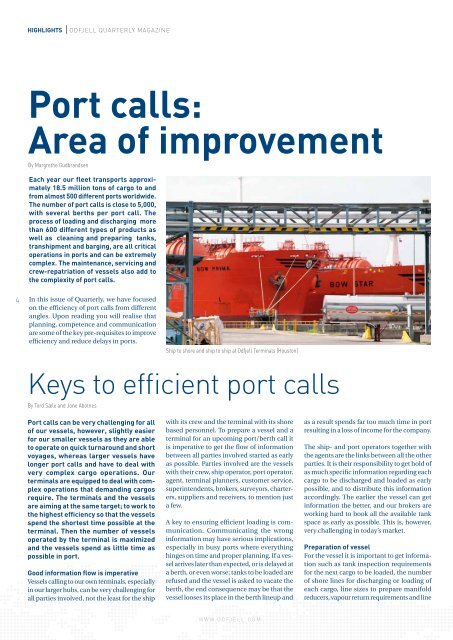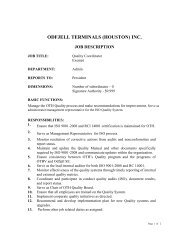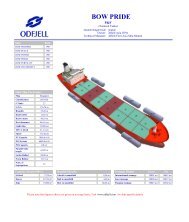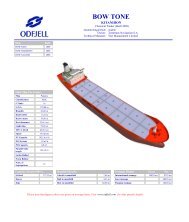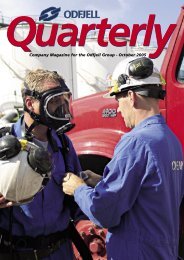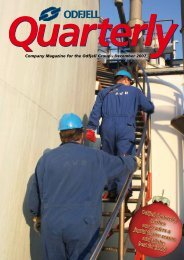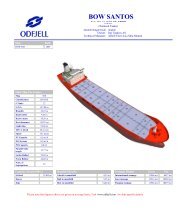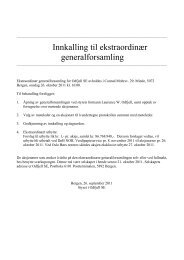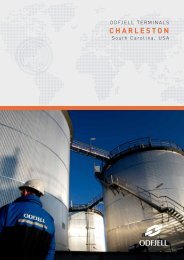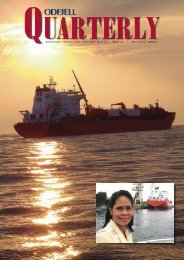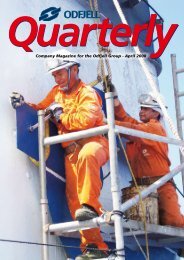Create successful ePaper yourself
Turn your PDF publications into a flip-book with our unique Google optimized e-Paper software.
4<br />
HigHLigHTS odfjell quarterly magazine<br />
Port calls:<br />
Area of improvement<br />
By Margrethe Gudbrandsen<br />
Each year our fleet transports approximately<br />
18.5 million tons of cargo to and<br />
from almost 500 different ports worldwide.<br />
The number of port calls is close to 5,000,<br />
with several berths per port call. The<br />
process of loading and discharging more<br />
than 600 different types of products as<br />
well as cleaning and preparing tanks,<br />
transhipment and barging, are all critical<br />
operations in ports and can be extremely<br />
complex. The maintenance, servicing and<br />
crew-repatriation of vessels also add to<br />
the complexity of port calls.<br />
In this issue of <strong>Quarterly</strong>, we have focused<br />
on the efficiency of port calls from different<br />
angles. Upon reading you will realise that<br />
planning, competence and communication<br />
are some of the key pre-requisites to improve<br />
efficiency and reduce delays in ports.<br />
Keys to efficient port calls<br />
By Tord Sæle and Jone Abotnes<br />
Port calls can be very challenging for all<br />
of our vessels, however, slightly easier<br />
for our smaller vessels as they are able<br />
to operate on quick turnaround and short<br />
voyages, whereas larger vessels have<br />
longer port calls and have to deal with<br />
very complex cargo operations. Our<br />
terminals are equipped to deal with complex<br />
operations that demanding cargos<br />
require. The terminals and the vessels<br />
are aiming at the same target; to work to<br />
the highest efficiency so that the vessels<br />
spend the shortest time possible at the<br />
terminal. Then the number of vessels<br />
operated by the terminal is maximized<br />
and the vessels spend as little time as<br />
possible in port.<br />
good information flow is imperative<br />
Vessels calling to our own terminals, especially<br />
in our larger hubs, can be very challenging for<br />
all parties involved, not the least for the ship<br />
Ship to shore and ship to ship at <strong>Odfjell</strong> Terminals (Houston)<br />
with its crew and the terminal with its shore<br />
based personnel. To prepare a vessel and a<br />
terminal for an upcoming port/berth call it<br />
is imperative to get the flow of information<br />
between all parties involved started as early<br />
as possible. Parties involved are the vessels<br />
with their crew, ship operator, port operator,<br />
agent, terminal planners, customer service,<br />
superintendents, brokers, surveyors, charterers,<br />
suppliers and receivers, to mention just<br />
a few.<br />
A key to ensuring efficient loading is communication.<br />
Communicating the wrong<br />
information may have serious implications,<br />
especially in busy ports where everything<br />
hinges on time and proper planning. If a vessel<br />
arrives later than expected, or is delayed at<br />
a berth, or even worse; tanks to be loaded are<br />
refused and the vessel is asked to vacate the<br />
berth, the end consequence may be that the<br />
vessel looses its place in the berth lineup and<br />
www.odfjell.com<br />
as a result spends far too much time in port<br />
resulting in a loss of income for the company.<br />
The ship- and port operators together with<br />
the agents are the links between all the other<br />
parties. It is their responsibility to get hold of<br />
as much specific information regarding each<br />
cargo to be discharged and loaded as early<br />
possible, and to distribute this information<br />
accordingly. The earlier the vessel can get<br />
information the better, and our brokers are<br />
working hard to book all the available tank<br />
space as early as possible. This is, however,<br />
very challenging in today’s market.<br />
Preparation of vessel<br />
For the vessel it is important to get information<br />
such as tank inspection requirements<br />
for the next cargo to be loaded, the number<br />
of shore lines for discharging or loading of<br />
each cargo, line sizes to prepare manifold<br />
reducers, vapour return requirements and line


